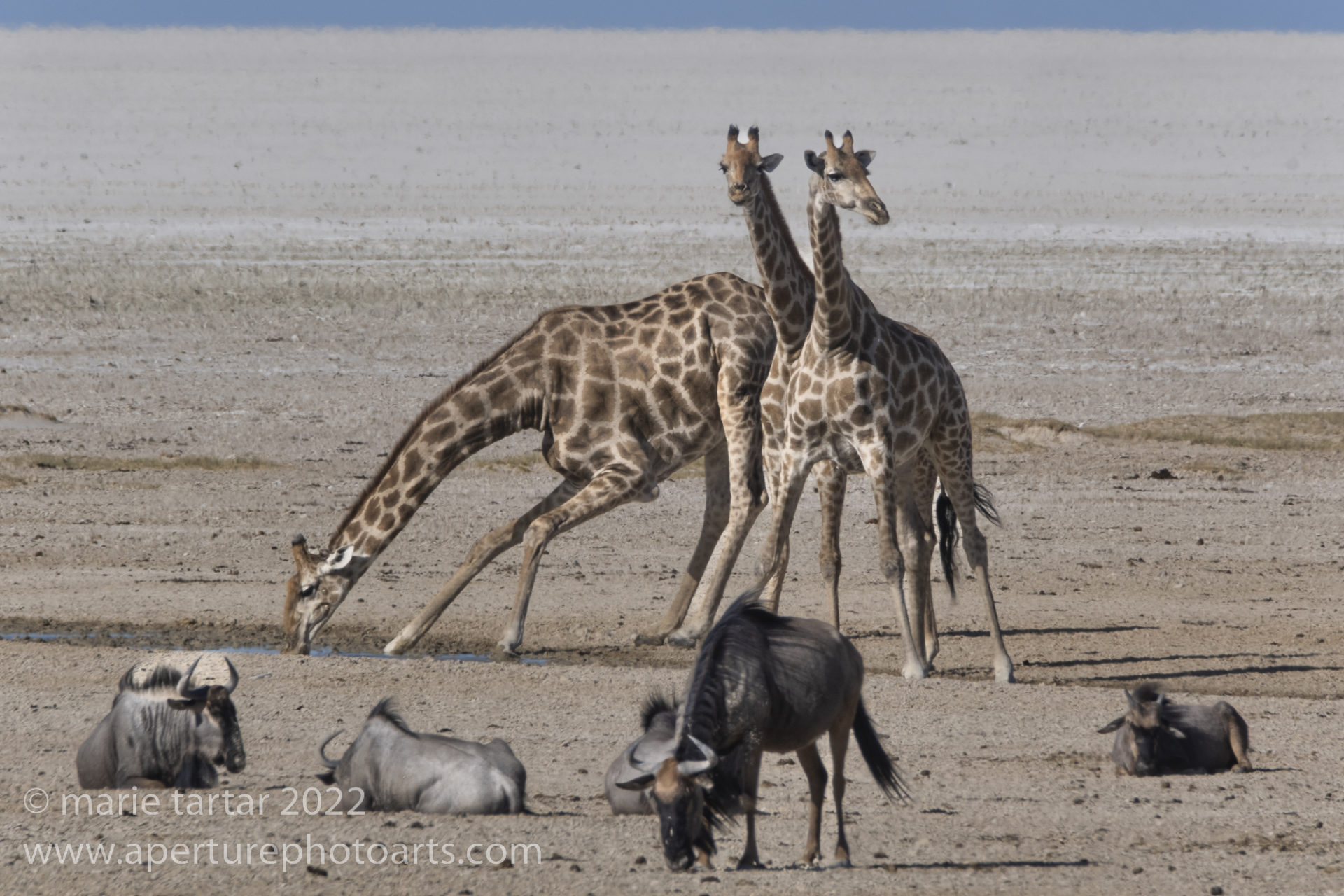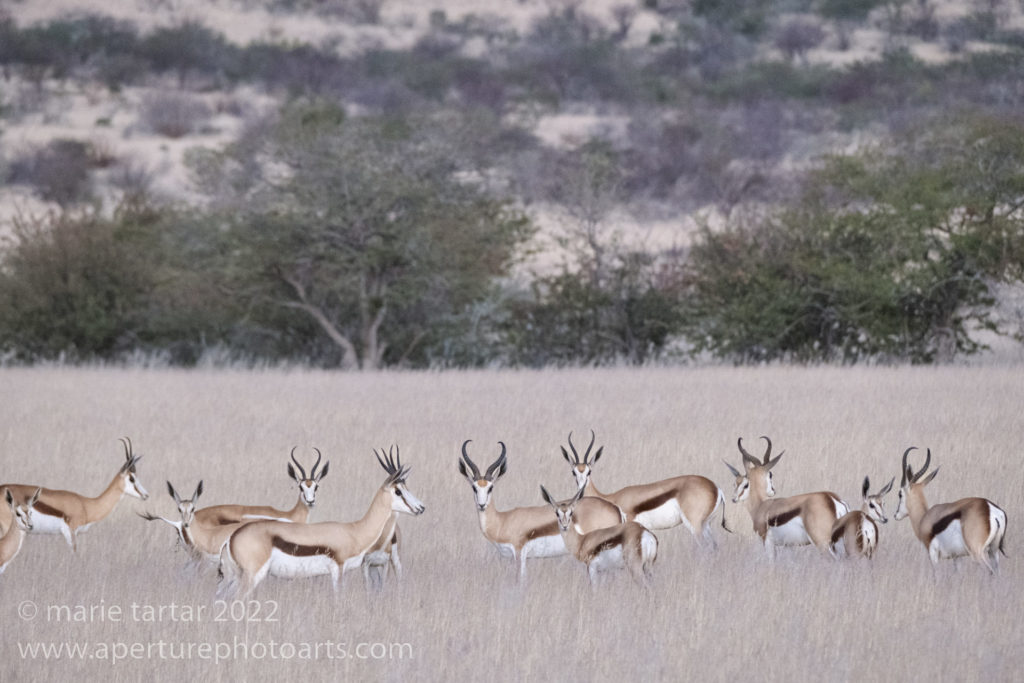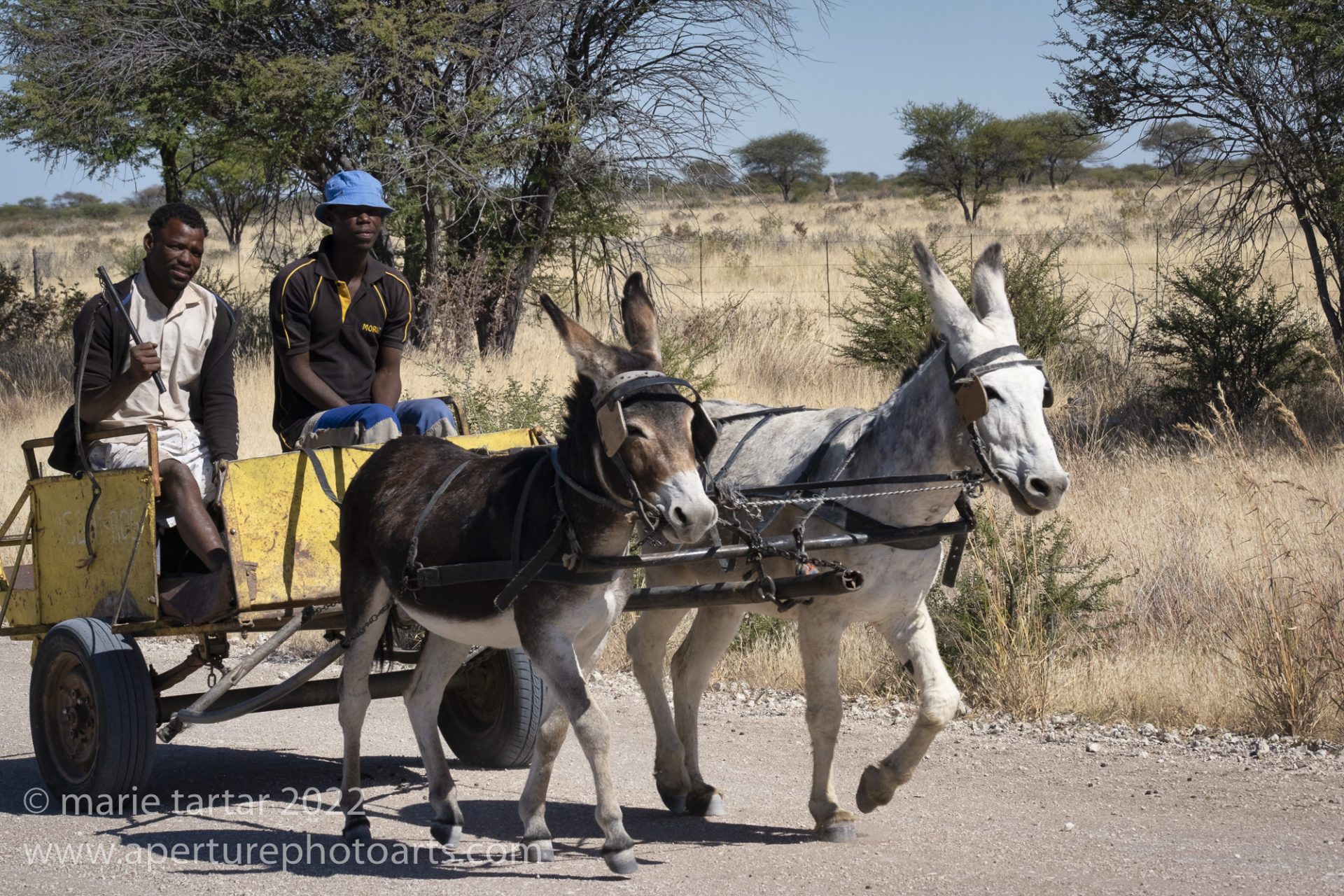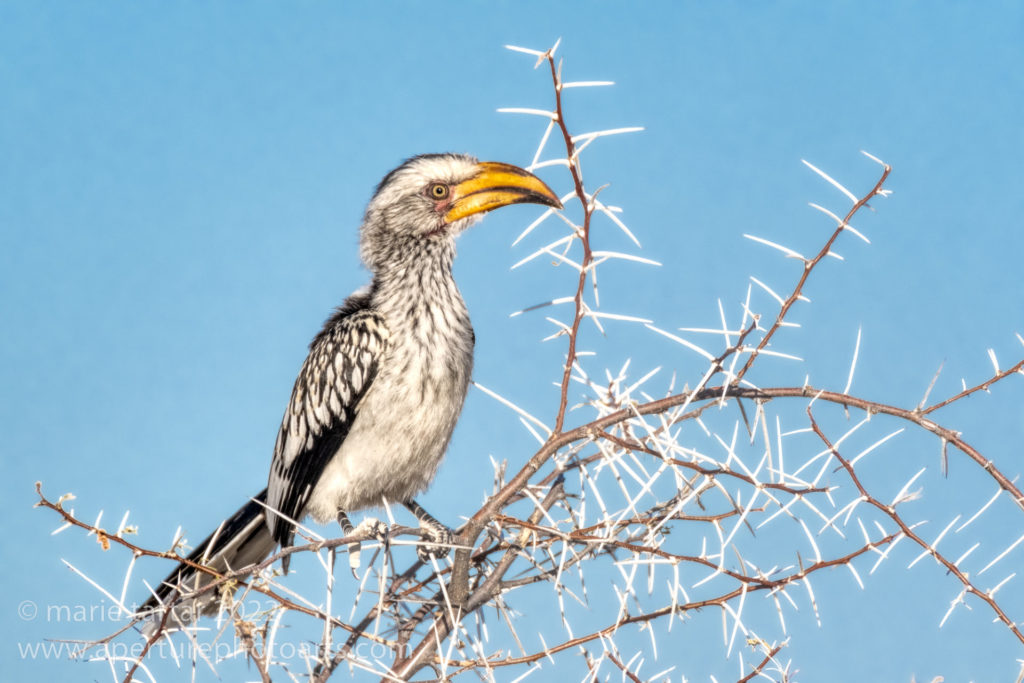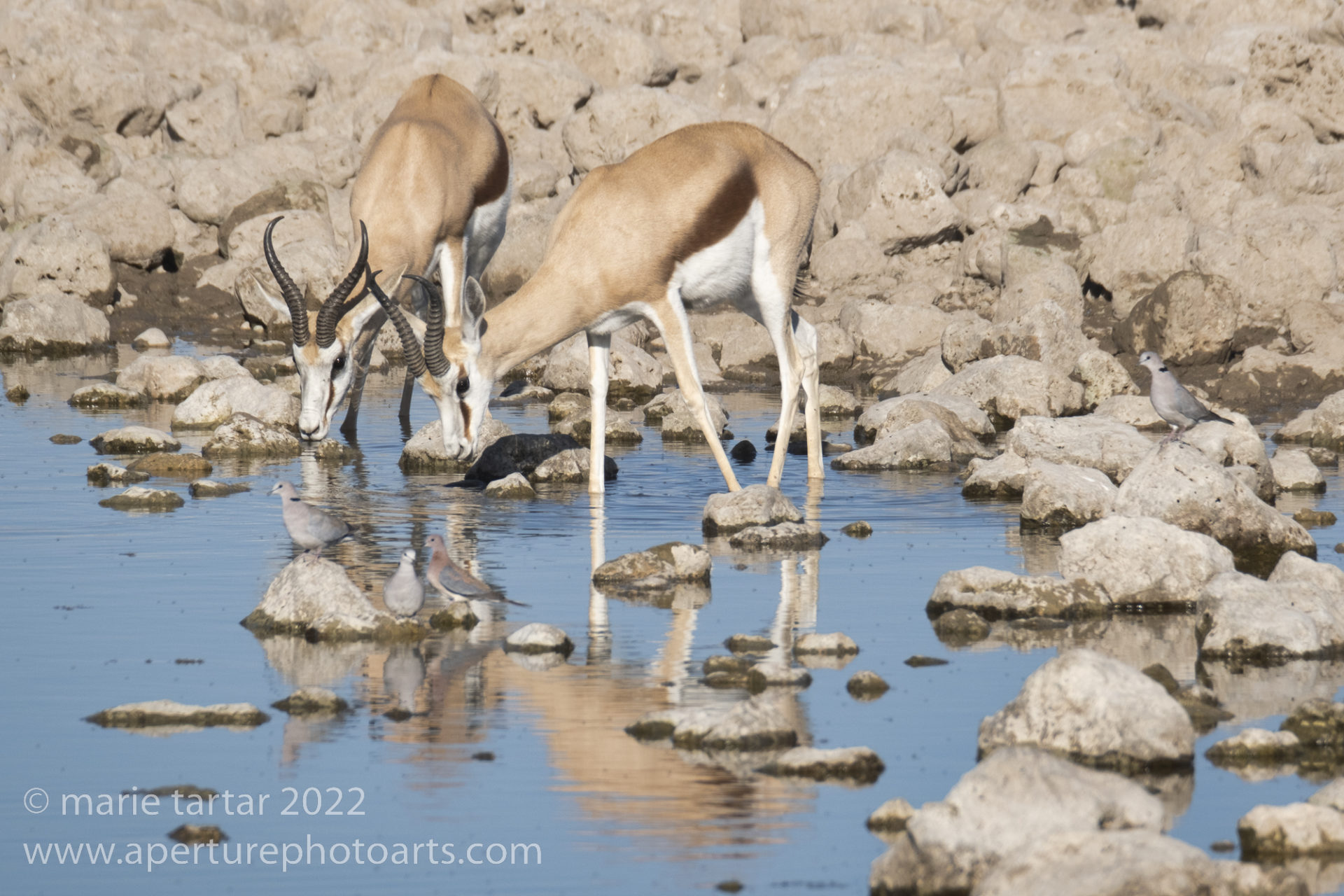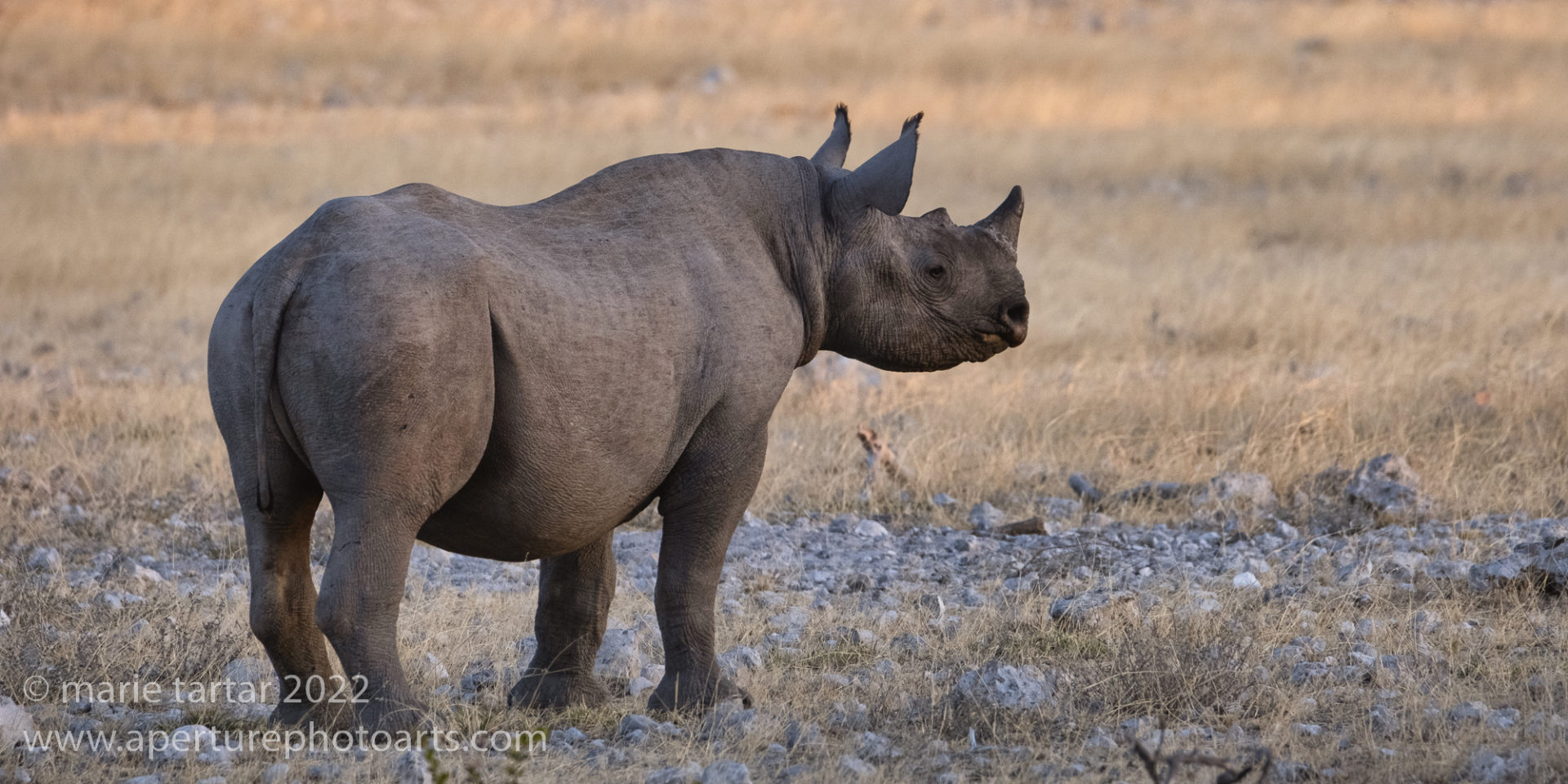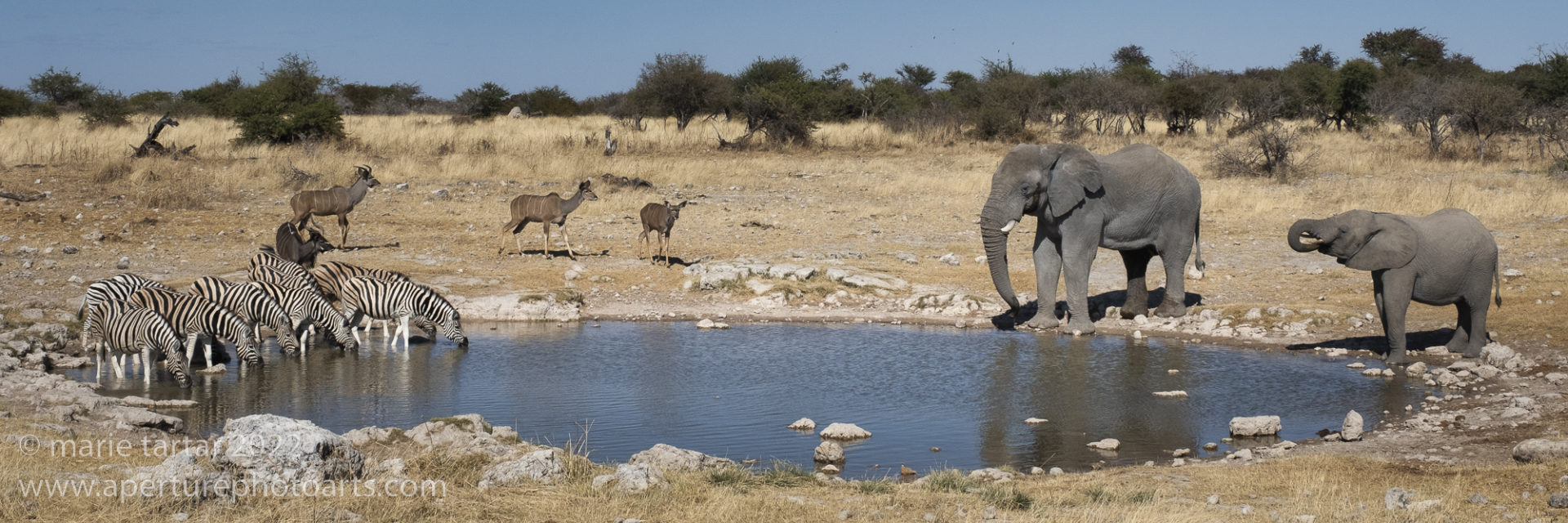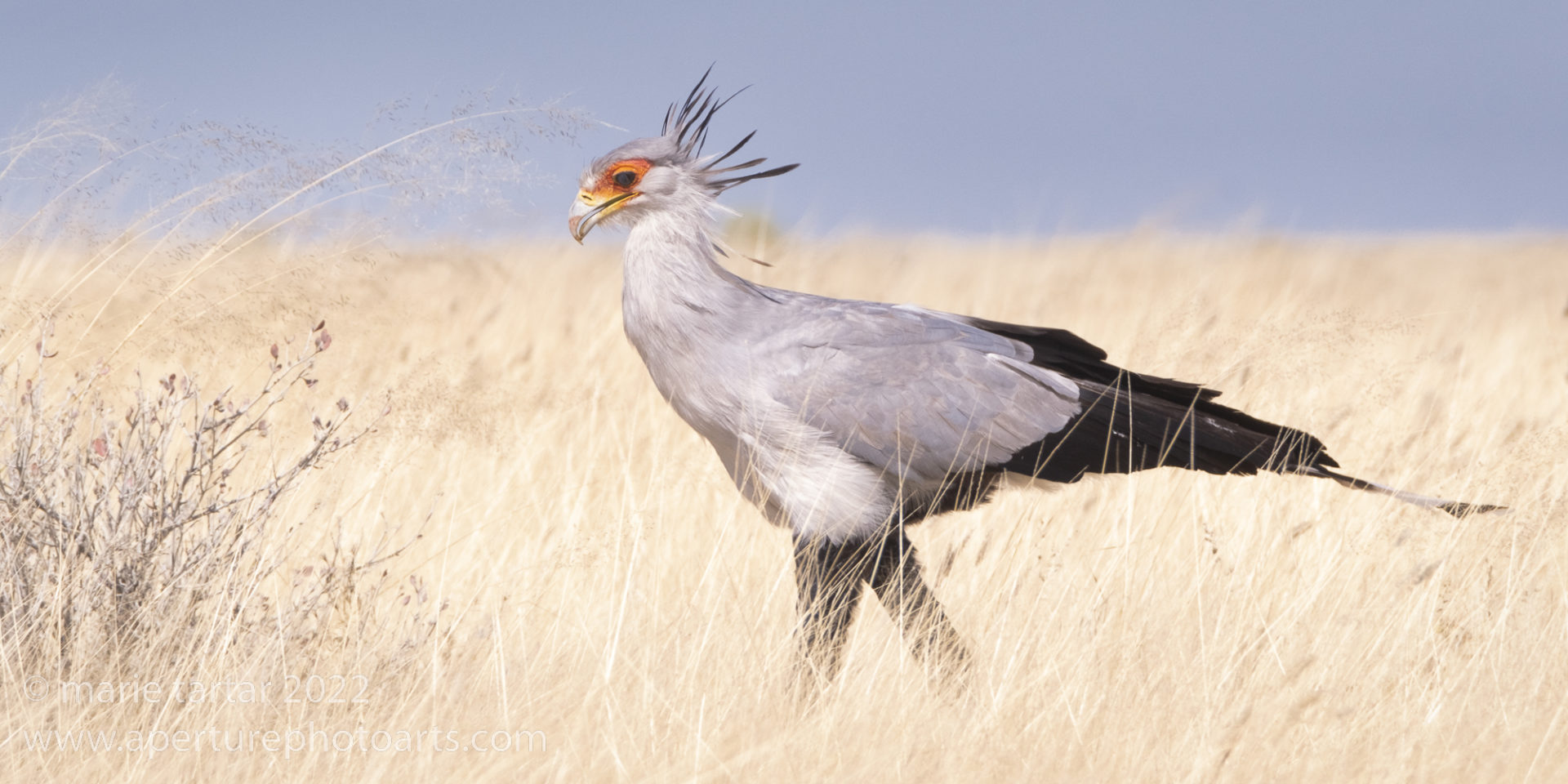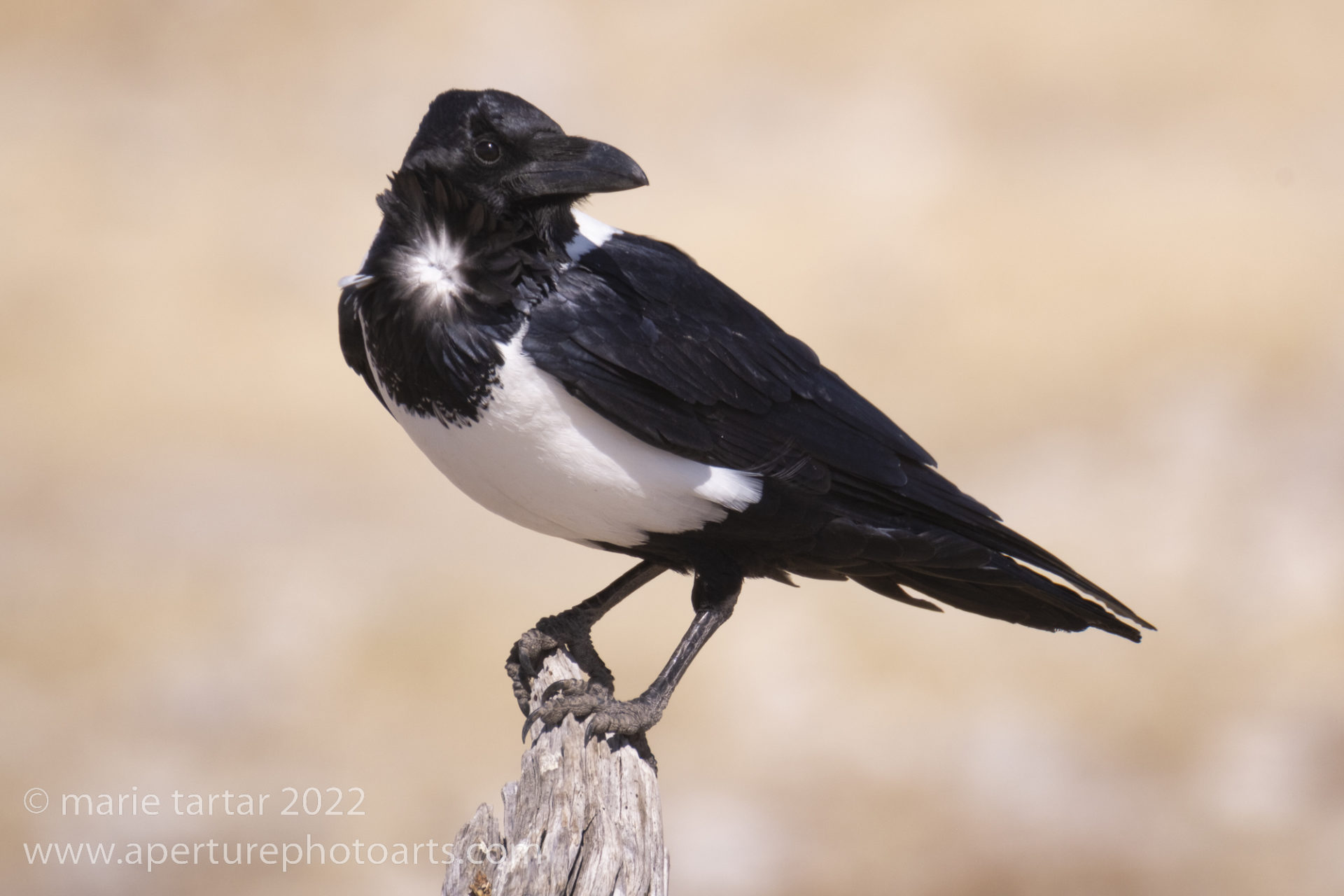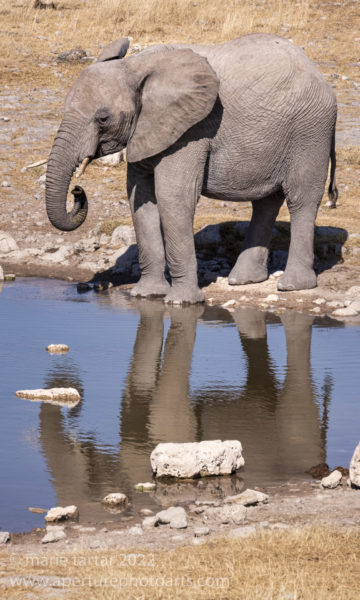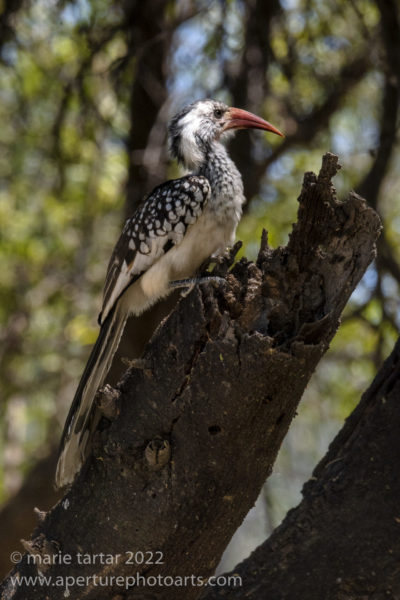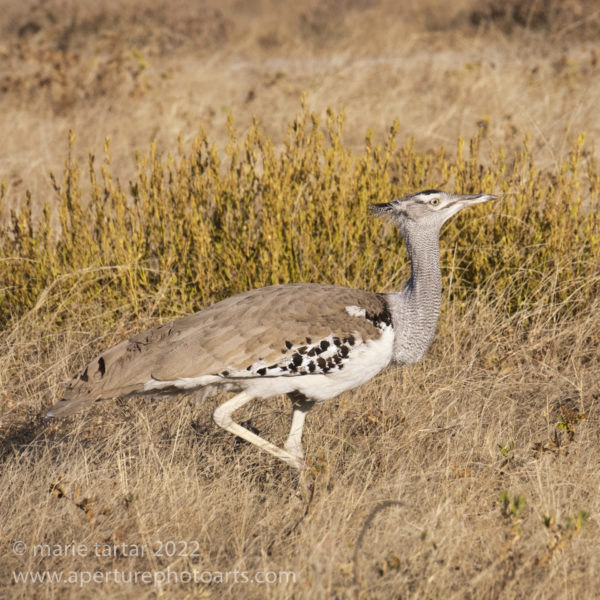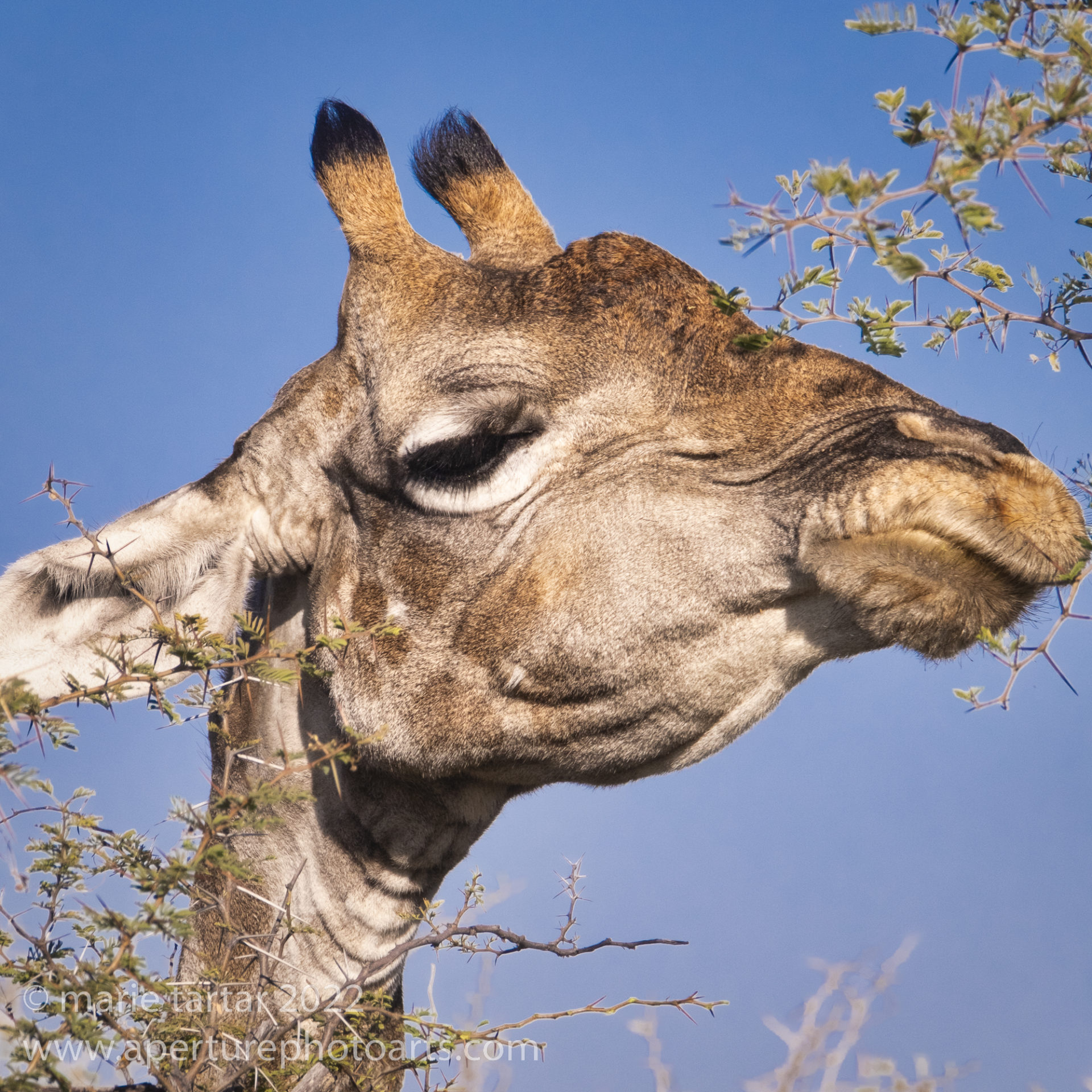
The final phase of our Namibia trip was devoted to wildlife, centered on Etosha National Park, in northern Namibia. Etosha means Great White Place, which refers to the massive mineral pan occupying 1/5 of the area of Etosha National Park, a largely dry lake bed fed by the Kunene River. During the rainy season, water may temporarily accumulate in the lake bed and partially fill it. Most of the wildlife sightings are made in watering holes around the periphery of the expanse. We stayed outside the Park in private, luxurious resorts, but stopped into the government run options inside the park for restrooms (“comfort stops”), lunch and to check out the watering hole activity at Okaukuejo, Halali and Namutoni (set in an old German fort).
For this segment of the trip, our accommodations were most luxurious and stylish, in a pair of private lodges on the western and eastern borders of the park, gorgeous properties with built-in wildlife viewing opportunities. By now, the five of us were good friends and comfortable in our varying daily accommodations in the vehicle, which was a good thing, as we now had another large companion which appeared regularly, now that we were on to the “serious wildlife” segment of the trip: namely, Jan’s 600 mm lens, a mighty behemoth, not quite half my height.
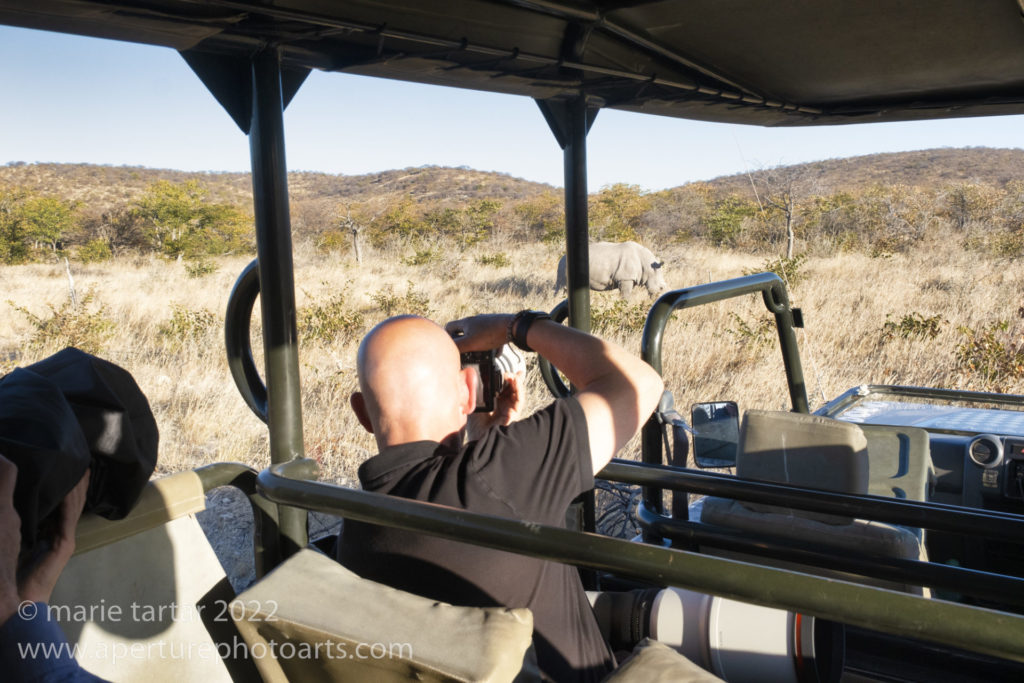
The elephant in the room, or the behemoth in the truck: the 600 mm lens on Jan’s lap. No need for it on this rhinoceros encounter, we were quite close!
Greg still stubbornly refused to remove the price tag adorning the broad-brimmed, frontier-style hat he acquired at the beginning of the trip.
Thursday, June 8, 2022
Palmwag to Ongava
At breakfast, we learned the identity of the strange nocturnal visitor to our back patio at the Palmwag Lodge. Steve was sitting outside processing images and hissed urgently for me to come quietly and look. A few feet away was a strange creature we had never seen, a cross between a dalmation (low to the ground, sausage shaped spotted body) with a thick bushy tail with wide stripes, as long as its body. The face was pointed and small.
A woman at an adjacent table in the open air dining room came up with a name for this apparition, with the aid of an electronic guidebook in her phone: spotted genet, a type of spotted cat.,
Speeding east along the gravel road towards Etosha National Park, we keep our cameras mounted with long lenses on our laps.
Jon and Jan halted our progress with a sighting of “a giraffe and an elephant “ on the right. Forster obligingly threw the truck in reverse and backed up until we could see distant giraffes, including one with darker and more closely spaced spots which, when bent over feeding, did resemble a distant elephant. Greg joked that it was a giraffe identifying as an elephant.
I finished reading Paradise, by the 2021 Nobel prize winning author Abdurazak Gurnah, on the drive to Etosha.
Lunch was a delicious hummus veggie wrap on the beautiful open air dining terrace of Ongava. The handsome and personable on-site host, Milton, was there to welcome us. Forster later told us he is something of a Namibian celebrity, formerly the host of a television show. Ongava has its own game reserve and for this afternoon, we set out on a game drive from the Lodge, Pascali.
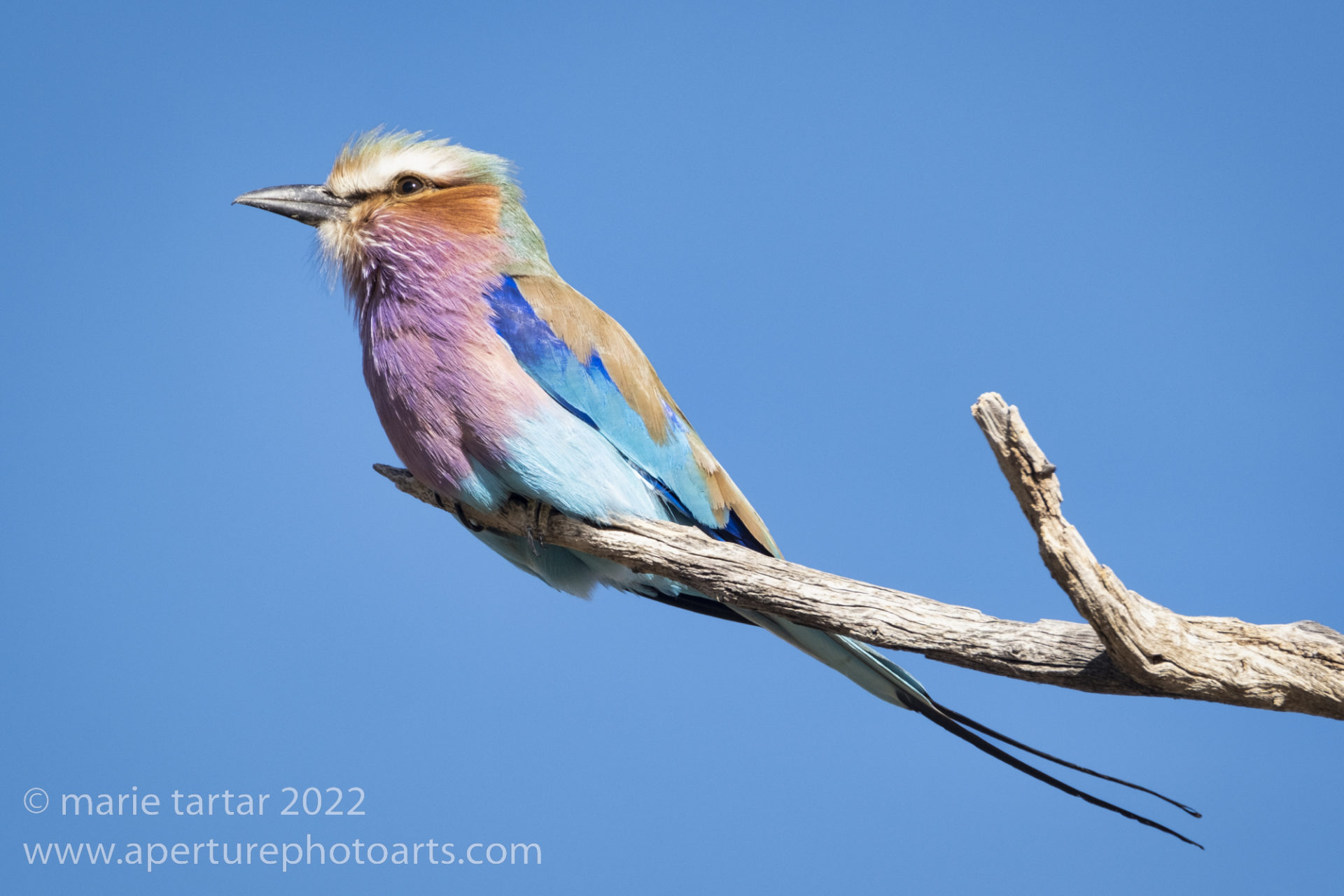
One of our first sightings was a favorite African bird, a beauty called a lilac breasted roller. The most beautiful African bird? Certainly, a contender.
We found a pride of lions resting in the shade and largely concealed by foliage. We had better luck with a white rhino encounter, as they ambled about, grazing on grasses.
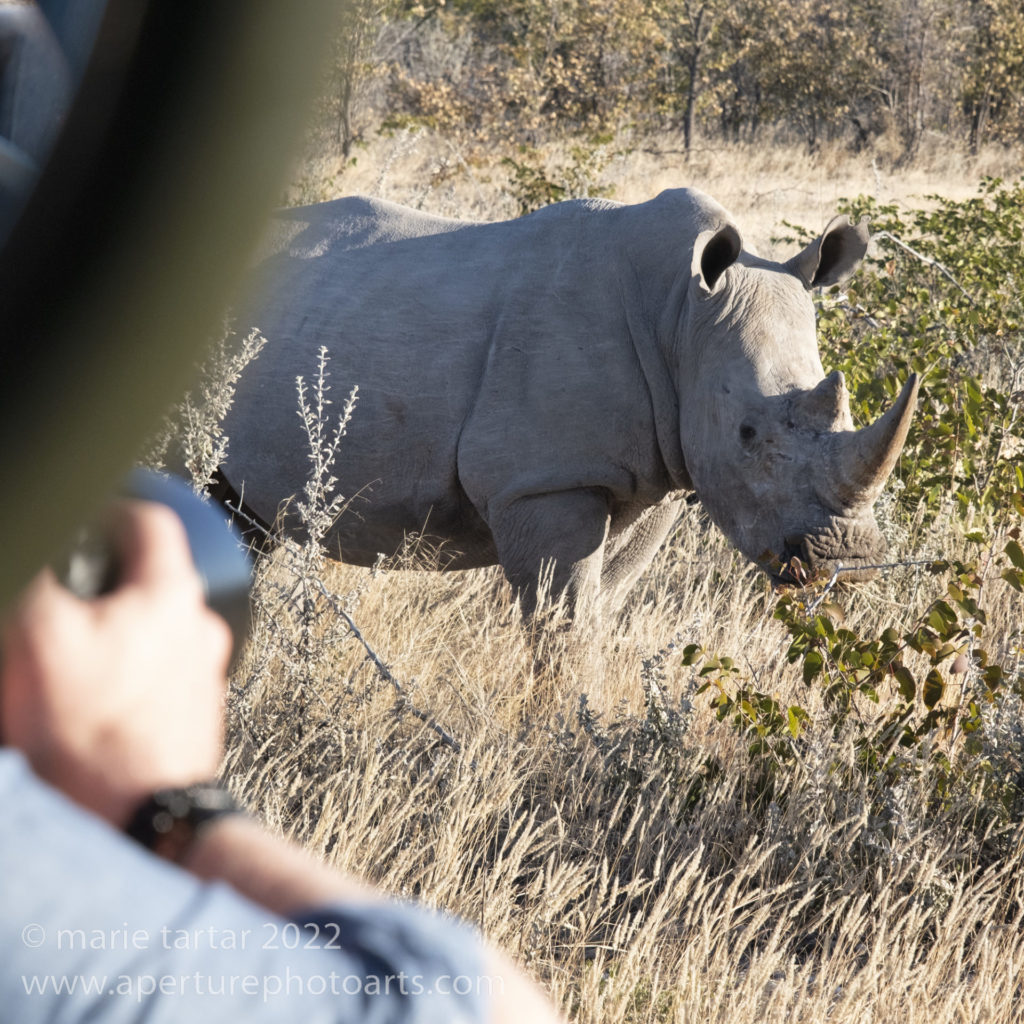
Yes, that’s Steve’s arm, a very close encounter with a mellow white rhino, Ongava, near Etosha, Namibia.

Truck as framing device on an almost close enough to touch encounter with a white rhino, Ongava, near Etosha, Namibia.

This was by far the best African trip for rhinos for us. White rhinoceros, Ongava, near Etosha, Namibia.
We had better luck with the lions circling back after the other vehicles cleared out.
We saw our first elephant of the trip by the truck’s headlights, on the road back to the Lodge. Stepping into the open air dining pavilion, we could see rhinos down at the watering hole. Down a fenced pathway leading to a large (room-size) blind, rhinos were drinking at the property’s watering hole. A baby rhino was nursing briefly when we tiptoed in, trying not to make any noise which might startle the animals away.
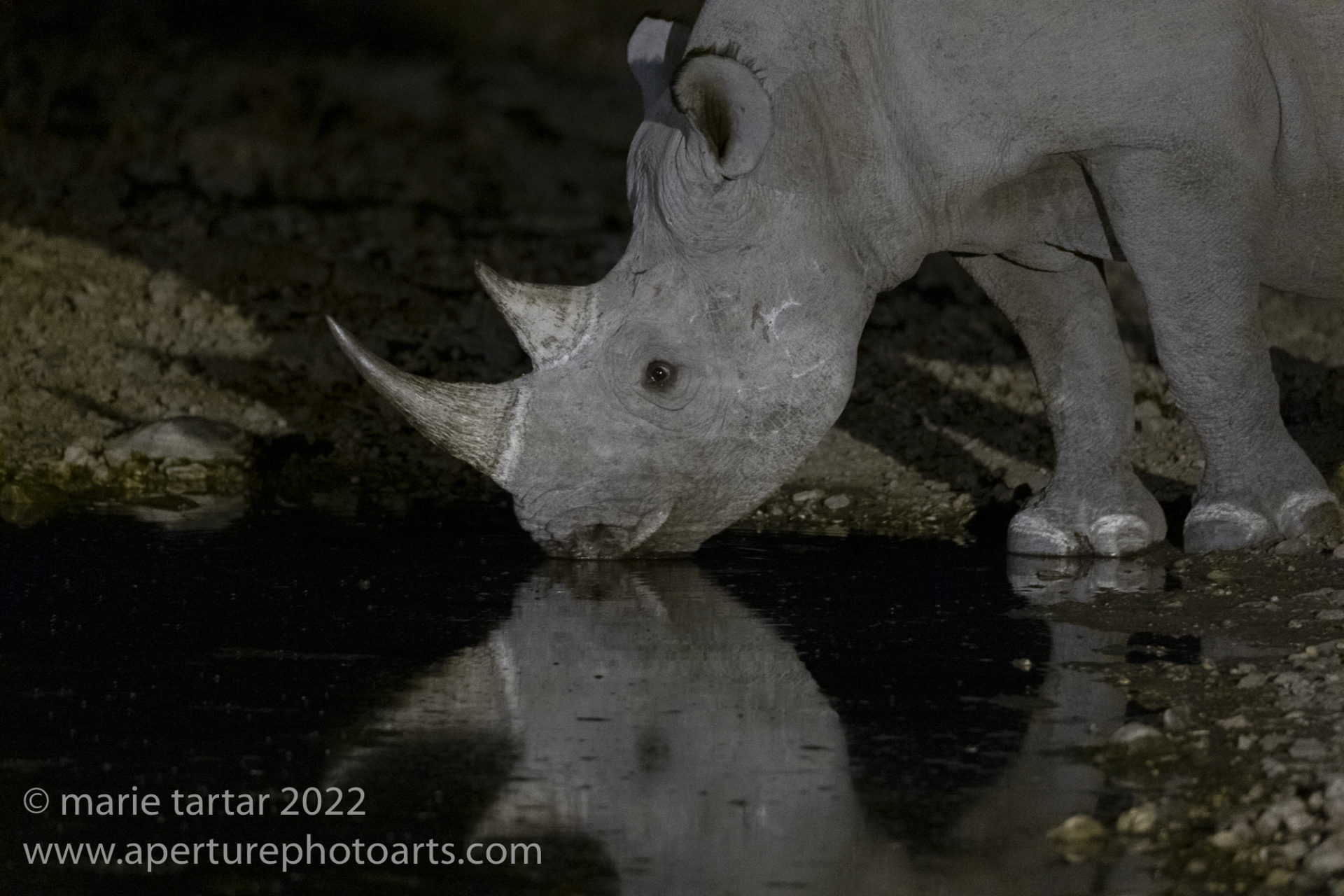
A white rhinoceros creeps silently down to a watering hole at the Ongava Lodge, outside Etosha National Park in northern Namibia, as we try not to knock our cameras on the metal platform of the room-size blind enabling this amazing sight.
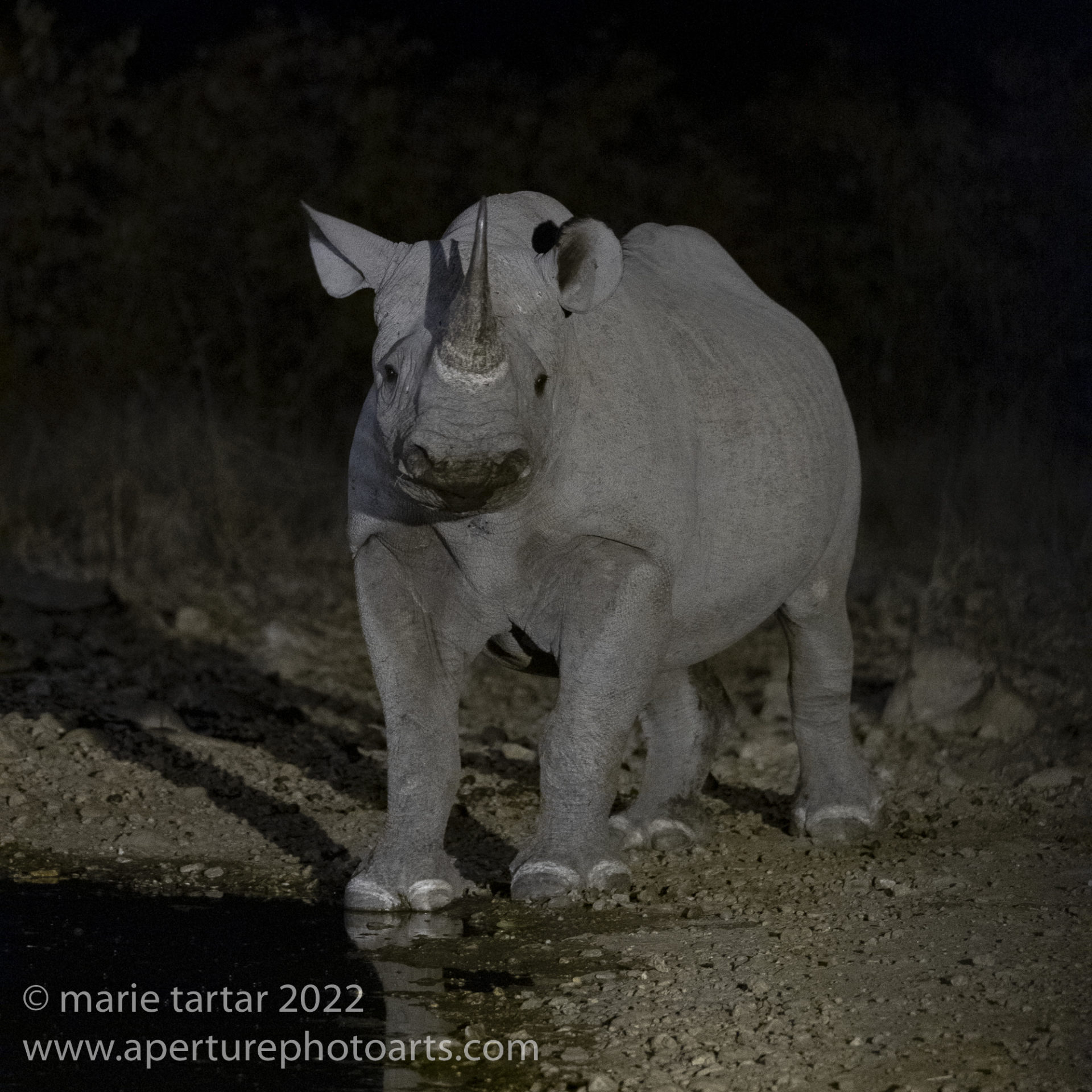
A young white rhinoceros stares toward our blind at Ongava Lodge, as we hold our collective breaths. Did we make a sound?
For dinner, I enjoyed the lamb shank with chimichurri sauce, topping off a wonderful day.
Friday, June 9, 2022
Today was one long game drive in the park with Forster, one sighting after another, beginning with steenboks (a small antelope).

Surely Disney’s model for Bambi? Actually, no, Bambi was modeled on a roe deer, a European deer. This is a steenbok, a small African antelope.
Burchell zebras and springboks queued up at a watering hole.
As the last glow of the afternoon began to fade, we made an unusual sighting: a jackal eating a snake.

Blackbacked jackal, just after it consumed a snake as we watched it, as the late afternoon light faded in Etosha National Park, Namibia.

White rhinoceros in Etosha National Park, Namibia. Prior to this trip, our sightings of rhinoceros in Kenya, had been very distant
Back at Ongava, we could see rhinos at the watering hole from the dining terrace, so wasted no time hightailing it down the fenced access to the blind.

Nothing like a reliable watering hole to bring in the animals! Black rhinoceros, Ongava Lodge, southwestern border of Etosha National Park, Namibia. How to tell black from white rhinos? Definitely not the color, they are both grey. The black rhino has a pointed upper lip, while the white has a more square mouth. The black rhino’s horns are more equivalent in size to each other, while the white rhino’s front horn is much longer than the back one.
Saturday June 11, 2022
We were sad to leave Ongava, but might not have been so reluctant had we known how delightful our next accommodation would be. Forster drove east across Etosha. A mongoose dove into hollow of a tree. We stopped again at Okaukeujo, where the zebras lined up at water’s edge until they were edged out by blue wildebeest.

A dazzle of zebras, a most appropriate name for a herd of zebras! Watering hole in Etosha National Park in Namibia.

The composition of watering hole attendees changed over time. As the zebras were sated, a flock of helmeted guinea fowl moved in.
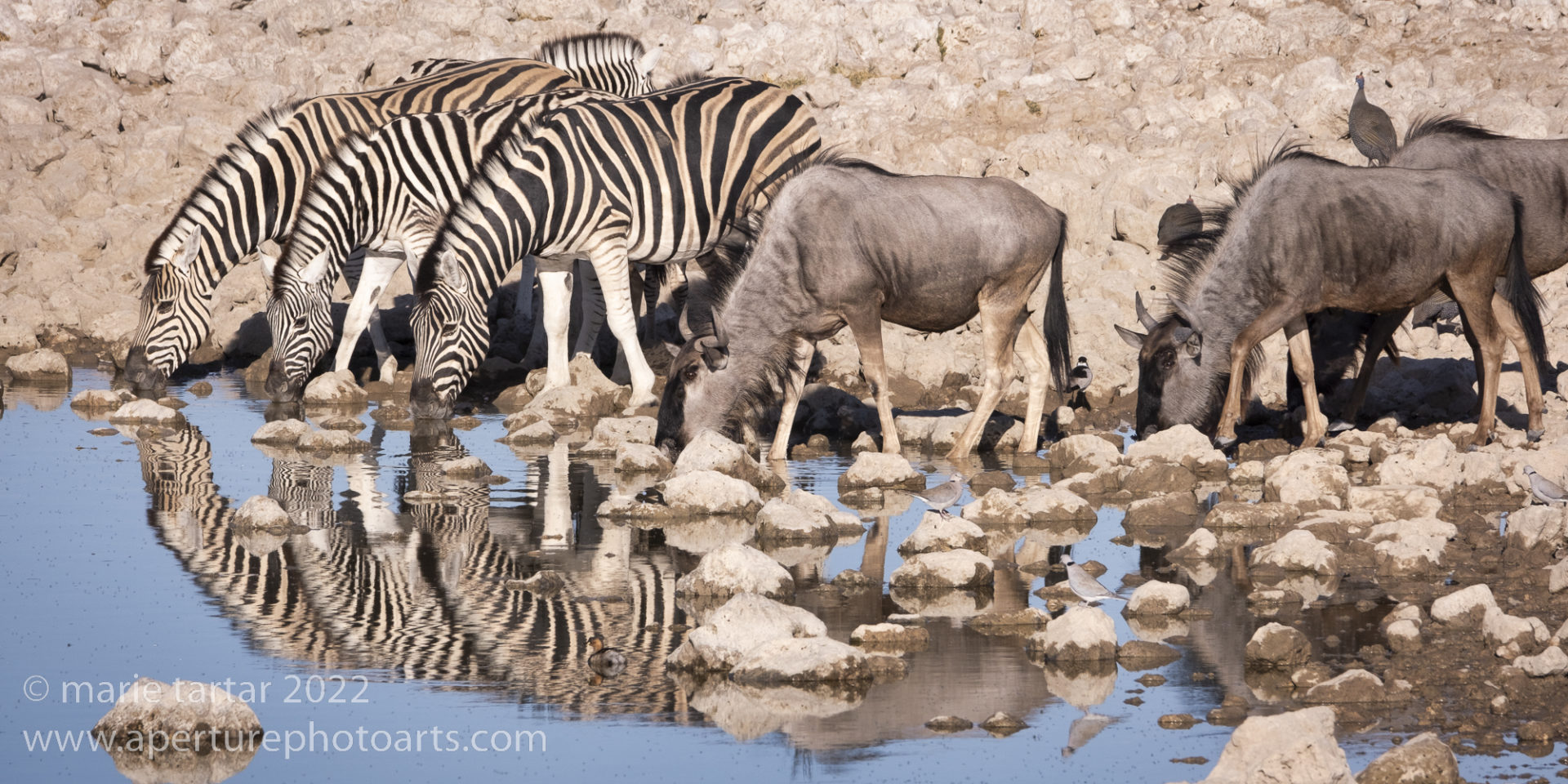
At the watering hole, Etosha National Park, Namibia: The guineau fowl were quickly slaked of their thirst, or else were intimidated by the wildebeest as they edged in.
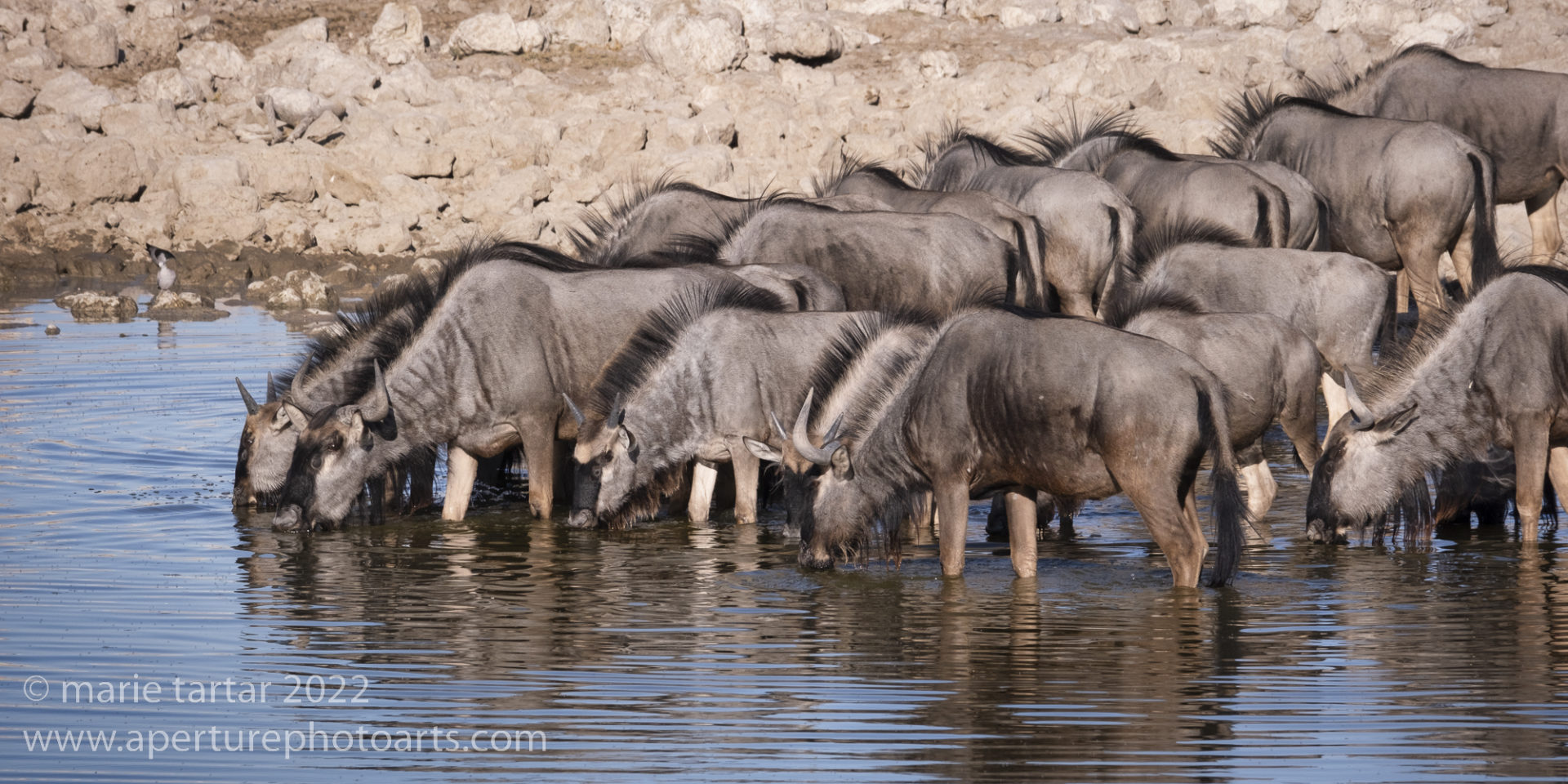
At the watering hole, Etosha National Park, Namibia: And finally, the zebras were completely replaced by an implausibility of wildebeests.
Guinea fowl and a single oryx milled about.
At Nebrowni, a similar mix of animals was less organized. Springboks were pronging in the distance.
Red-billed queleas were lined up on overhanging tree branches. We would later see huge flocks moving as a coordinated murmurating wave. A tawny eagle was spied in their midst. A trio of feeding elephants and hornbills rounded out our morning.

A family of kudu, a large antelope (one of my favorite antelopes) at a watering hole in Etosha National Park, Namibia.

Zebras, tete-a-tete, gather at a watering hole punctuating the vast aridity of Etosha National Park in northern Namibia.
From a great distance, we could make out a leopard with a springbok kill under a tree, when it raised its head from the golden grasses which largely concealed it. Springboks were on high alert.
Forster said its name comes from how it bobs its head as it consumes a kill on the ground, mimicking the motion of fingers hovering over typewriter keys.
After lunch at Reitfontein, we headed to another watering hole, where giraffes came in for a drink.
A pied crow stopped by, as did a male bull elephant and a tawny eagle.

African elephant at a watering hole in Namibia’s Etosha National Park. We had been frustrated in our quest to see desert elephants on our drive to Etosha but our guide Forster was confident in promising us we would see elephants in Etosha; we were not disappointed!
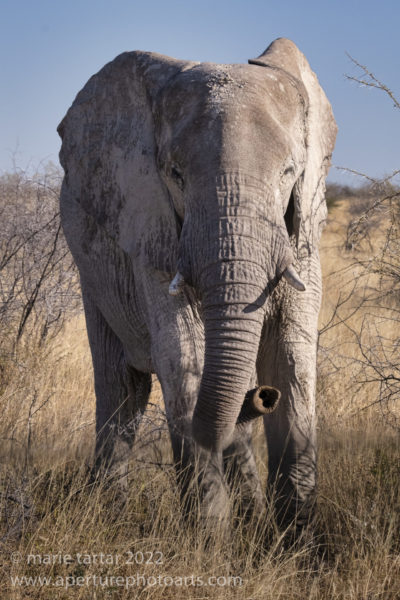
Our guide Forster promised we would see definitely see elephants in Namibia’s Etosha National Park and indeed we did!

A white rhinoceros grazes on grasses in Namibia’s Etosha National Park. The name is thought to be a mistranslation of the Dutch for wide (wijd), referring to the wide, square mouth and jaw of the so-called white rhino )which is just as gray as the black rhino, which has a pointy upper lip).
We spied another white rhino in the gold grasses and admired a stand of giraffes drinking at a watering hole.
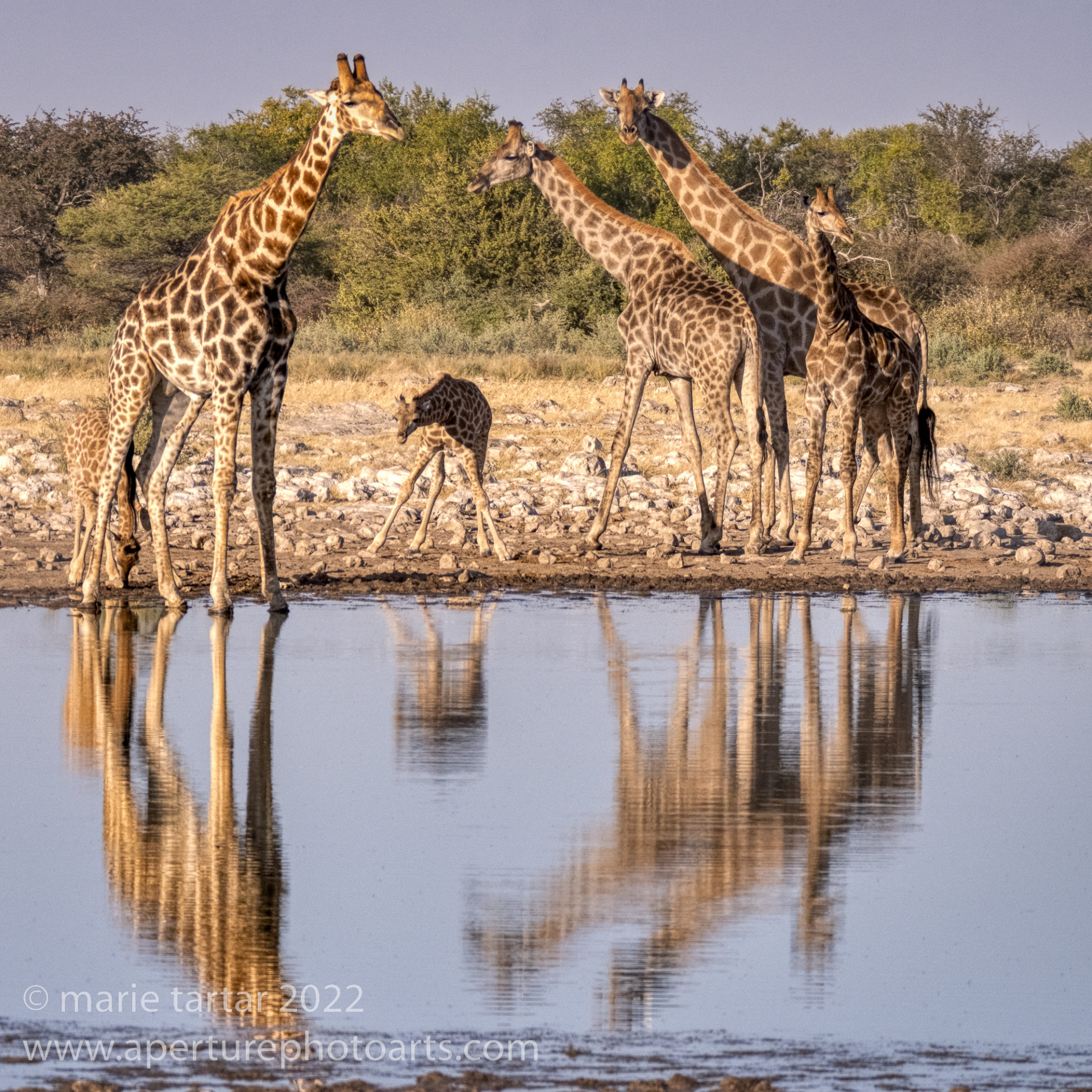
A tower of giraffes arrays itself protectively around a vulnerable calf taking a drink at a watering hole in Namibia’s Etosha National Park. Another calf takes refuge under the legs of an adult.
Along DikDik Drive, dikdiks made only fleeting appearances. We had a good time tormenting Greg, who was terrorized as a “wee lad” on safari with his family by a dikdik (the smallest antelope, tiny) , when he was chased around a parking lot by one of the same height.
Sunday June 12, 2022
We sighted cheetahs only very distantly with jackal and wary wildebeests.

African elephant in profile, grazing in golden Namibian grasses, June 2022, in Etosha National Park.
At Klein Okevi, an elephant was trumpeting, keeping company with kudu and a single warthog.
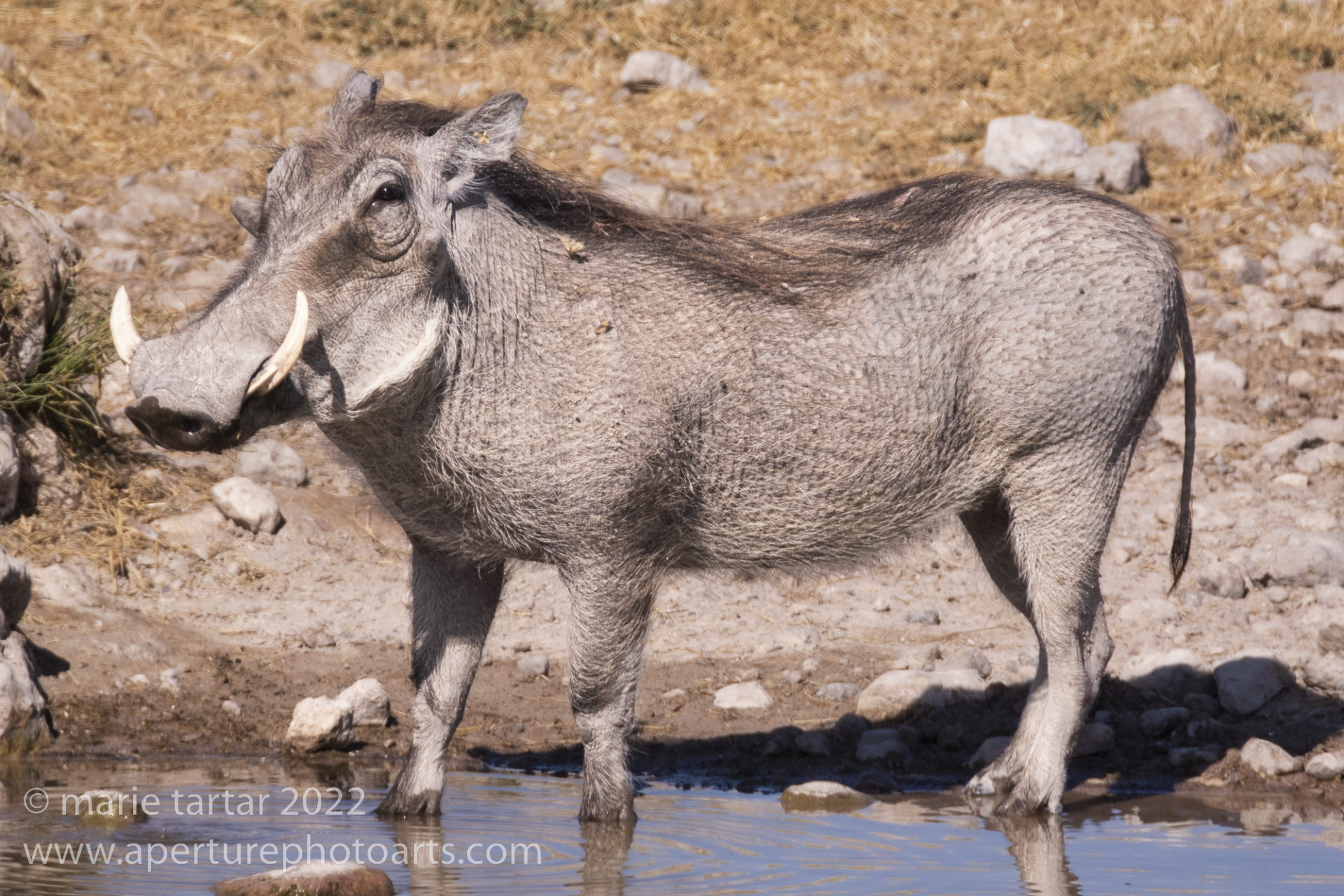
Everyone comes to the watering hole in the desert: Warthogs need to drink too, Etosha National Park, Namibia.
In the afternoon, we tried again to exorcise Greg’s terror of dikdiks with another drive on Dikdik Drive, but the tiny horned creatures failed to show.
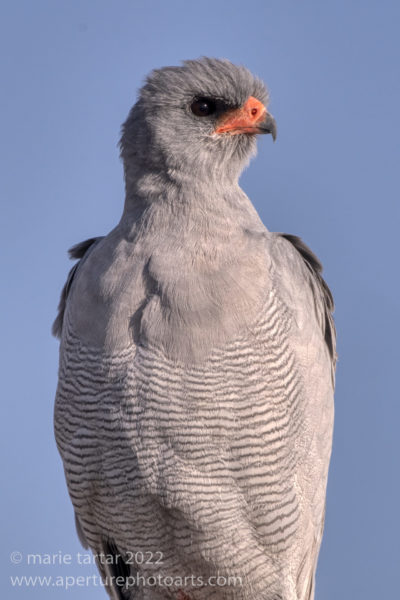
One of the first and one of the last birds we sighted in Namibia, this one in eastern Etosha National park: the Southern pale chanting goshawk.
At Klein Numatomi waterhole, a massive stand of giraffe kept us clicking.
Back at the beautiful Lodge, I had a brief glimpse of elephants at the watering hole before succumbing to the heavenly ministrations of Johan, the masseuse.
Monday, June 13, 2022 and Tuesday, June 14, 2022
I enjoyed my a last favorite Lodge breakfast, the vegetarian burrito. En route back to Windhoek, we stopped at a coffee shop with a great name, Brewed Awakenings. Jan introduced me to a South African dish, vetkoek (aka fetcook), a deep fried bread dough with curry mince. It was a better alternative than the chicken curry Martin especially found “inedible”.
Back at the River Crossing Lodge, we sadly took leave of Forster. He learned during our journey that his wife suffered burns opening a pressuring cooker and he had cancelled his next guiding engagement to return home earlier. He was an excellent linchpin for this trip, expertly driving the long distances between our destinations and positioning the vehicle to maximize the photographic possibilities for all. We all enjoyed his sense of humor and knowledgable commentary on the history of the places we visited. He was also a great source of natural history information on the animals we saw, readily distinguishing young from mature, female from male and one species from another.
We were all on the same non-stop 10 hour Lufthansa flight from Windhoek to Frankfurt, before dispersing to Switzerland (Jan), England (Jon), Japan (Martin), Chicago (Greg) and NYC (me and Steve, for a few days to recover from jetlag and catch up on some theatre).
I was unable to get comfortable in any position on the flight to Germany, so passed the time catching up on film viewing. The Eyes of Tammy Faye was an interesting, more nuanced than expected portrait of the much-parodied televangelist half of the Tammy Faye and Jim Bakker duo. Jessica Chastain won an Academy Award for Best Actress for this role.
I caught up on the second half of the House of Gucci, which I had started on the trip to Namibia. It stars Lady Gaga and Adam Roper as Patrizia Reggiani and Maurizio Gucci, a couple scheming to take control of the family fashion enterprise.
Stopping to chat with Greg, he was so engrossed in The Outfit with Mark Rylance, that I queued it up for my final screening. A crime caper set in the Chicago underworld, its twists and turns kept me engaged and awake and I managed to finish it just before deplaning.
In Frankfurt, Jan had a quick turnaround to his connecting flight, while the rest of us had much more leisurely waits. Steve and I passed the 8 hours with Jon and Greg in the comfort of the Lufthansa lounge, which features a pretzel bar! Arriving at 6 am, we initially had the place nearly to ourselves, before it steadily filled up. I beat the crowd in securing a shower, while Greg, Steve and Jon were issued pagers to summon them when one was available. Towards noon, we peeled off one by one, Greg first, then me and Steve on to our 8 hour flight to Newark. At least Jon only had a 2 hour flight to Newcastle once his boarding time did eventually roll around.
I caught up on sleep on the flight to Newark, between screenings, starting with The United States vs. Billie Holiday. Singer Andra Day was phenomenal in her first acting role as Lady Day, a perennial favorite of mine to this day.
It would take much time to fully process all we had seen in Namibia. This was a full and fascinating grand tour of this wonderfully varied and interesting country, from the amazingly dark sky and spectacular Milky Way, to the dramatic dunes and landscapes, not to mention the marvelous animal life. Months were required to savor the memories and process the images, all souvenirs of a tremendously satisfying voyage, well worth waiting 2 years of pandemic postponement. Steve, Greg and I received a small Covid related gift just before our departure from Namibia, when the US requirement for a negative Covid test to return was lifted 2 days before our return, hopefully a sign of an improving coronavirus situation and easier future travel, even better with this great pod of dedicated photographers, hopefully now now!
-Marie

